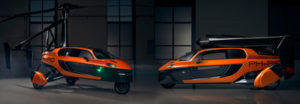Limited Edition Flying Car production Model unveiled at GIMS
PAL-V unveiled its PAL-V Liberty Pioneer, the world’s first production model flying car at the Geneva International Motor Show (GIMS) 2019 . The 90-piece limited edition is based on the PAL-V Liberty which was unveiled last year at the GIMS. It will open the next chapter of mobility. Delivery of this limited edition ( only 90 to be produced) is in 2020.
The PAL-V Liberty Pioneer Edition is equipped with a dual control cockpit and the Electronic Flight Instrument System. The full carbon package with tailor-made interior and, exclusive characteristic two tone colour scheme distinguishes the Pioneer from the standard Liberty.
“Developing a flying car takes a long time and a lot of persistence. It’s a revolutionary development, especially as PAL-V developed a commercial vehicle that complies with existing regulations, very different from an interesting technical concept.”
According to Dingemanse,CEO of PAL-V: “The Pioneer Edition is for those that want to be part of a unique group that writes history with us. They will be at the forefront of a mobility revolution, where we will no longer have cars that can only drive.They will be the first carflyers in their country, FlyDriving to any destination.”

Although more and more flying concepts are announced, only a handful of companies work on a real flying car: one that can both fly and drive, ideal for city to city mobility. The combination offers unprecedented freedom: personal door-to-door flying mobility,” said Mike Stekelenburg, Chief Engineer at PAL-V. As Stekelenburg continues: “The gyroplane principle not only provides us with a safe and easy-to-operate flying car but it also enables us to make it compact and within existing regulations, which is the most important factor to build a useable flying car.”
PAL-V Liberty for now can carry two passengers which is sufficient to cover a very big portion of the market its creators believe.
PAL-V International B.V., the company that initiated the development of the PAL-V, is located in Raamsdonksveer, The Netherlands. The company was founded in 2007 and funded by a group of professional and private investors. It also received funding from the Dutch Ministry of Economic Affairs. Three Dutch ministries are supporting the project based on its technical innovation and economic potential.
PAL-V is designed within todays existing regulatory framework with all the tools in place for safe management of transportation in the sky -including 2nd Generation air traffic control. Rules and regulations are in place under the International Civil Aviation Organization (ICAO) to allow the use of the first PAL-V LIBERTYs.
The PAL-V needs a space for take-off of about 90-200 by 20 metres (100ft-650ft by 60ft) without surrounding obstacles. This is about the same for all small airstrips, aerodromes, glider sites and/or ultralight airfields. The PAL-V LIBERTY can operate from either concrete or grass airstrips. As the PAL-V popularity increases, it is expected that more and more small uncontrolled airstrips will be created. Many countries also allow for special permits on private property.
A license to fly will be required for the PAL-V which can be obtained through one of the many flight schools in the world. Basic knowledge of navigation, instruments, meteorology, aerodynamics and performance will be necessary. Training will be required which is estimated at 30-40 hours for a gyroplane license.
To convert from drive to fly mode or vice versa will take 5-10 minutes. The company states that there is no need to change any regulations to the PAL-V to open up the City-to-City mobility, which makes the PAL-V a viable flying car without barriers.
Source: PAL-V International B.V.